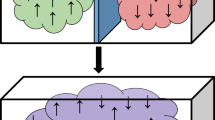Abstract
In undergraduate courses in statistical or quantum mechanics, students are exposed to quantum and classical particles that are described as being identical or indistinguishable. It is difficult to appreciate this terminology unless real-world examples are given to illustrate the different possibilities. In particular, while it is easy to think of systems of identical indistinguishable particles or of nonidentical distinguishable particles, it requires more care to identify a gas of identical distinguishable particles.
Similar content being viewed by others
Suggested Reading
S Chaturvedi and S Biswas, Fermi-Dirac statistics: Derivation and consequences, Resonance, Vol.19, pp.45–61, 2014.
J F Nagle, Regarding the entropy of distinguishable particles, J. Stat. Phys., Vol.117, pp.1047–1062, 2004.
D S Corti, Comment on ‘The Gibbs paradox and the distinguishability of identical particles’, Am. J. Phys., Vol.80, pp.170–173, 2012.
B R Johnson, J S Denker, N Bigelow, L P Lévy, J H Freed, and D M Lee, Observation of nuclear spin waves in spin-polarized atomic hydrogen gas, Phys. Rev. Lett., Vol.52, pp.1508–1511, 1984.
R H Swendsen, Statistical mechanics of colloids and Boltzmann’s definition of the entropy, Am. J. Phys., Vol.74, pp.187–190, 2006.
H Peters, Demonstration and resolution of the Gibbs paradox of the first kind, Eur. J. Phys., Vol.35, p.015023, 2014.
M J Klein, Note on a problem concerning the Gibbs paradox, Am. J. Phys., Vol.26, pp.80–81, 1958.
W Ketterle, Bose-Einstein condensation: Identity crisis for indistinguishable particles, Chapter 9 in J Evans and A S Thorndike (Eds.), Quantum Mechanics at the Crossroads Springer, Berlin, 2007.
R P Feynman, R B Leighton, and M L Sands, Lectures on Physics, Vol.III, Section 3.4, Addison-Wesley, Reading MA, 1965.
Author information
Authors and Affiliations
Corresponding author
Additional information
Carl Mungan is an Associate Professor of Physics at the United States Naval Academy, educating approximately 4000 future Navy and Marines officers. His research interests are in optical spectroscopy of condensed matter, with emphasis on laser cooling of solids, stimulated Brillouin scattering in optical fibers, and photothermal effects.
Rights and permissions
About this article
Cite this article
Mungan, C.E. Identical distinguishable gas particles in the real world. Reson 20, 44–46 (2015). https://doi.org/10.1007/s12045-015-0151-1
Published:
Issue Date:
DOI: https://doi.org/10.1007/s12045-015-0151-1



